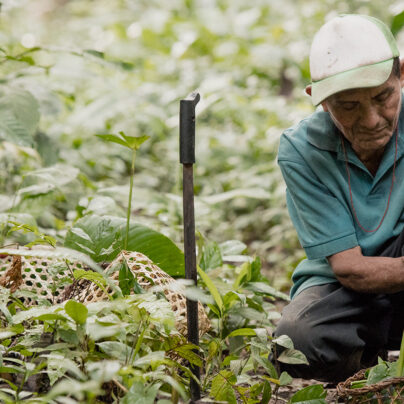The Art Of Fire
Dancing With The Forest Spirits In Papua New Guinea
Dan Hume
There was a twinge in the pit of my stomach as I waited to board a plane in Manila. Adrenaline surged every time I glanced up at the information screen and caught sight of my destination: Port Moresby, Papua New Guinea’s notorious capital.
The anticipation grew throughout the bumpy six-and-a-half-hour flight across the easternmost part of the Indonesian archipelago, and I could hardly sleep. My search for traditional fire-making techniques was luring me to this great island for the third time in two years. There’s an incredible magic about New Guinea; I think it’s the most exciting place on Earth. It’s the second-largest island in the world after Greenland and one of the most mysterious, with more than 900 languages spoken there. It’s also home to the biggest expanse of rainforest outside of the Amazon, interrupted only by a 1,000-mile spine of snow-capped mountains and an interior inhabited by some of the most traditional indigenous people left on our planet. My final destination was the Bismarck Archipelago off the north-east coast of the mainland – little known and rarely visited. There, in the jungle-clad mountains of East New Britain, the Baining tribe has lived for thousands of years; a people that continue to lead a very traditional life and are known for their relationship with fire, which they portray in their extraordinary dances.
My previous visits had been to the western half of the island – both Papua and West Papua, each provinces of Indonesia – to search for the ‘fire thong’. This ancient fire-making technique involves running a thin length of flexible rattan vigorously around a larger dry stick. This time, however, I was looking for the ‘fire plough’, a completely different technique that is used eastwards from Papua New Guinea to the Solomon Islands, Vanuatu, New Caledonia and all the way to New Zealand, as well as among the scattering of islands throughout the vastness of the Pacific Ocean, in Samoa, Fiji, Tahiti and Hawaii. It is the most wonderfully simple technique; it has to be seen to be believed.
The tip of one stick – the plough – is vigorously rubbed backwards and forwards in line with the grain, in a channel on top of another length of wood. This produces a charred dust, which coalesces into an ember at the farthest end of the channel. Many will know the technique from its use in the film Cast Away. In a powerful scene, Chuck, played by Tom Hanks, struggled for hours to make a fire using the hand drill. Finally, he gave up and tried another method, the fire plough, and succeeded.
When I first read about the Baining people, I knew immediately that I had to go. Not only did they conduct fascinating dances and rituals associated with fire, but I suspected they would fall within the fire plough’s geographical zone. It would be the perfect combination for one of the chapters in my book.
After a comfortable night in Port Moresby I boarded a morning flight on a prop plane to Rabaul, East New Britain’s disaster-prone capital. Having spent an hour gazing dreamily out of the window down onto the Solomon Sea, I glanced up at the horizon and could just make out the faint, jungle-clad mountains of New Britain looming in the distance. Half an hour later the scene changed abruptly from blue sea to vibrant green rainforest bordered by aquamarine coral reefs. As we descended into Rabaul I counted at least four or five volcano cones, including the infamous Mount Tavurvur. A thin grey plume gently rose from its crater. This truly was the land of fire.
As we descended into Rabaul I counted at least four or five volcano cones, including the infamous Mount Tavurvur. A thin grey plume gently rose from its crater. This truly was the land of fire.



After a few days by the coast exploring the area and organising a visit to the Baining, I bumped and crawled in an old 4×4 up into their territory in the hills further inland. It was pleasantly cooler higher up and my hosts welcomed me graciously. They cooked a delicious meal of chicken with local vegetables wrapped in banana leaves, baked using hot stones from the fire. That afternoon seemed different – there was no heavy downpour as there had been every day since I’d arrived, and that night the stars shone beautifully. It was the perfect setting for the dance.
I was led out to a clearing in the forest where a few young boys were squatting down to set light to a pile of dry palm leaves. As the flames grew, the master of ceremonies continued to pile firewood onto the fire until 10ft-high flames licked the sky. A dozen or so men began to beat drums and bamboo sticks and let out loud and uplifting chants. The atmosphere continued to grow, and as the fire blazed with more wood, a murky, shamanic figure appeared on the edge of the clearing, assessing the scene. He began to lead out the dancers one by one into the flickering light cast by the fire.
As I had anticipated, the men stepped out wearing elaborately painted masks with immense startled white eyes, like owls or monsters, laboriously made from bark cloth and bamboo. Their legs and bodies were human but their heads were otherworldly, with large beaks and wild eyes gazing around and casting towering shadows across the ground.
As I had anticipated, the men stepped out wearing elaborately painted masks with immense startled white eyes, like owls or monsters, laboriously made from bark cloth and bamboo. Their bodies were draped with a variety of leaves from the forest; the masks and outfits are said to be representatives of the bush spirits who live there. Their legs and bodies were human but their heads were otherworldly, with large beaks and wild eyes gazing around and casting towering shadows across the ground. Traditionally, their costumes are used only once for the dance ceremony before being thrown into the fire and destroyed. The young men seemed to warm themselves up and draw strength from the hypnotic banging and chanting as they bounced in unison with the beat, circling the edges of the fire, kicking the flames and sending a shower of sparks into the night sky. They were preparing themselves for the dance, communing with the spirits of the forest and moving energetically around the fire. It’s as though the dancers were no longer human; their dress coupled with the bewitching chanting had transformed them into supernatural beings of the forest.
The tropical air was muggy, the fire searing. Even though I was several metres away from the fire, sweat poured off me like water. I sat knowing the scene playing out before me had been repeated on countless occasions over thousands of years: a powerful concept. The anticipation of what was to follow seemed to affect everyone. As I looked around me, at the vast shadows of the masks, the sparks of the fire and the energetic dancing, the electricity in the air was palpable.
Suddenly, as the music reached a climax, one of the dancers careered into the fire, releasing a million sparks up into the air – nothing to protect him except the magic of the fire. Up and up they went, rising high on the thermal column pushing up into the darkness, mingling as they ascended, as if a swarm of fireflies had been set free. The brave dancer emerged apparently unscathed on the other side of the fire, scattering glowing coals across the ground which were promptly stamped out as they settled by the barefooted dancers. The flames seemed to suffer a little but they soon regained their vigour. Before I knew it, another dancer committed himself and repeated the act, this time lingering in the centre of the fire for a few seconds, the flames devouring his bare legs before he leapt out and continuing to dance as before. The evening drew on and it was as though I had been transported to a different time and place. Tradition says the dancing must continue whilst there is still wood to burn – and the mountainous stack meant that this party was not going to end prematurely.



The Baining traditionally conduct their dramatic dances to mark special occasions: to celebrate the birth of a child, to mark the commencement of their harvests, to remember their dead, or as a rite of passage when initiating young men into adulthood. Sometimes, large feasts are prepared where taro, pigs, pythons, and cassowaries are cooked and eaten before the dance. Anyone can spectate, but only initiated men can observe the ‘secret place’ in the bush where the dancers adorn themselves in preparation for dancing. Similarly, women and children must not see the masks that are worn other than when a dance is taking place.
Apart from their spectacular fire dancing, one of the scenes that sticks in my mind most was after I had settled in and started to build a relationship with the Baining. I asked them if they could show me their traditional way of making fire. The young men knew what I meant and began trying to demonstrate, but it just wasn’t working; they were trying but there was no smoke, no ember. It was apparent that these young men had never had to rely on this skill. After a while, an older man came over, saw what they were doing and intervened. He went off into the forest with some of the others and returned with carefully selected pieces of coastal hibiscus. He then sat down, shaped the wood with his machete, and made fire in a matter of seconds.
The young people of the community, probably about 40 people, had gathered around and were amazed at what they saw, mouths open and eyes shining. As soon as the spurt of short-lived flames from the coconut-husk tinder bundle had died down, everyone seemed invigorated by what they’d just witnessed. Many began picking up any piece of wood they could find and started replicating what they had just seen. It was an incredibly moving moment. Here was a community breathing life back into their culture and traditional knowledge – knowledge that may well have disappeared completely, given a few more years. Men and women young and old were helping to keep the old way alive.
This experience was not unique in my quest for fire. There were several times when I met communities where the modern world had only very recently started to exchange traditional knowledge for new equipment. This is not something we can stop, nor should we, although it is easy to view these things with a romantic eye. It’s a natural progression, of course.
That being said, I do think it is important to keep a record of indigenous knowledge, and to blend it in to modern life wherever that knowledge retains its relevance and offers benefit. Today, the level of reliance upon the fire plough, as well as most of the other traditional methods of fire making, varies greatly; in more remote areas of the Bismarck Archipelago, it is still heavily relied upon. Even the teenagers I met on neighbouring New Ireland – barely 40 miles from Rabaul – were very adept, and even now it is an everyday part of life for most. In other areas, it is called upon on the odd occasion when matches and lighters run out; in some places it has become redundant from a practical point of view, but continues to be practised and passed on to younger generations as an important part of cultural identity. Like the food these communities eat together, the way they converse, the skills they pass down through the generations, this ability to conjure fire is a critical part of their culture.
The Art of Fire is a fascinating, highly accurate and long-overdue account of fire making techniques from across the globe. Find out more here.
Daniel Hume is a naturalist, author, photographer and wilderness guide. For more than a decade he was an instructor and head of operations for Ray Mears school of wilderness bushcraft. In 2017 he left to set up how own business.
Website: www.danhume.com
Instagram: @danhumeuk
Facebook: /danhumeuk






